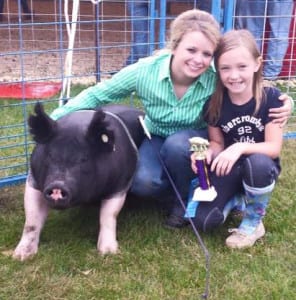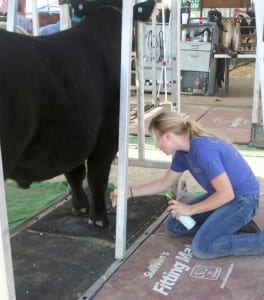For many of us, our lives do not solely revolve around showing horses. After a long weekend at a horse show, parents head back to their nine-to-five jobs; youth go back to school; and trainers head back to the barn. Some students might juggle both sports and horse shows. However, for exhibitors who show both livestock and horses, you can find them back in the barn working with their cattle, pigs, and sheep. Personally, I was lucky enough to be able to show both livestock and horses throughout my youth career.
While my mom and I would travel across the country for horse shows, I had help from my father who would work with my livestock while I was gone. No matter what you show, it takes a team effort to make everything come together. The people who stand with you at the back drop are a combination of family, friends, and trainers that make showing worthwhile. The lessons that are learned from showing are ones that you hold onto forever. The long hours of being in the barn and late night rides make it all worth it when you are handed that purple banner or world show trophy. (Pictured right, article author: Danica Weber)
For top horse show exhibitors, Bailey Anderson, Sydnie Ochs and Taylor Brown, their passion belongs in the show ring, whether that is leading a steer, driving a pig, or jogging down the center. They are responsible for not just managing their school, but also raising livestock while competitively showing their horses all across the country. We talked to them about how they were able to be successful in both arenas and what lessons they learned showing in both industries.
Bailey Anderson
 Congress and Reserve World Champion, Bailey Anderson has not only had success with horses, but also with show steers. Bailey describes that sometimes it got difficult juggling both horses and cattle. The busiest time of year for cattle begins in February. It was hard for her because one of the biggest majors for cattle is the Fort Worth Stock Show, which always conflicted with the Arizona Sun Circuit. Having to choose between the two was always hard, but she would normally end up in Fort Worth. Anderson says that her most memorable memory from showing cattle was winning her class at the Houston Livestock Show and Rodeo.
Congress and Reserve World Champion, Bailey Anderson has not only had success with horses, but also with show steers. Bailey describes that sometimes it got difficult juggling both horses and cattle. The busiest time of year for cattle begins in February. It was hard for her because one of the biggest majors for cattle is the Fort Worth Stock Show, which always conflicted with the Arizona Sun Circuit. Having to choose between the two was always hard, but she would normally end up in Fort Worth. Anderson says that her most memorable memory from showing cattle was winning her class at the Houston Livestock Show and Rodeo.
Another busy time of year is in the summer during her county fair. Normally, Anderson would show on a Wednesday and leave right after to drive to Illinois for a Quarter Horse show. “The hardest part of showing both was finding time to work on each animal every day, especially when I would have more than one steer. But I always found the time to ride my horse every day and I was lucky enough that my dad helped me a lot with the steers,” Bailey says.
According to Bailey, preparing for the majors is pretty similar for both. Before taking her calves to the majors, she tries to go to some smaller shows beforehand to get them out and used to things. Also, she says working on them every day coming up to the show is key.
“Having a good hair coat on cattle is very important for the winning look. They need to be rinsed and have their hair blown out every day. Showing cattle is similar to showing halter except you have to really work to get seen by the judge,” Bailey says.
Because you have to really stand out to get seen in the cattle pen, showing livestock has helped Bailey perfect her showmanship skills. “Horse showing is different than showing cattle, as the judging is more objective. Scoring systems, judges education and testing are not something we see in the cattle industry. The other thing that is so different is at a terminal event. Once the steers are fat steers, they are shown and sold at a terminal show,” Bailey explains.
The Anderson’s view it more like a business; invest in a steer to hopefully show successfully and turn a profit. While growing up showing cattle, it has taught her lot of patience. “Most cattle are more hot tempered than horses,” Bailey says. “Showing cattle has taught me a lot about hard work and responsibility.”
Sydnie Ochs
 The Ochs Family raise show cattle located in Milton, Wisconsin. They have been showing both cattle and horses for quite some time. Sydnie shows Zippos Lightair and was the 2014 Quarter Horse Congress Reserve All Around Novice Youth and Congress Champion in the Novice Youth Horsemanship.
The Ochs Family raise show cattle located in Milton, Wisconsin. They have been showing both cattle and horses for quite some time. Sydnie shows Zippos Lightair and was the 2014 Quarter Horse Congress Reserve All Around Novice Youth and Congress Champion in the Novice Youth Horsemanship.
“I am very lucky to have my family that helps me with my steers and lambs while I am on the road showing my horses,” Sydnie told us. “My sister works really hard on the steers so that they are ready for me to show. Cattle take a lot more preparation than horses because you have to break them, teach them to set up and have perfectly groomed hair on them all in about nine months.”
Sydnie says that winning her county fair has been her biggest accomplishment showing livestock. They have the largest Jr. County Fair in the state of Wisconsin. She says that winning the Wisconsin State Fair is one of her biggest goals.
Showing at both shows has not been an issue for the Ochs family until this year when their county fair and state fair conflicted with the AQHYA Youth World. “This was Sydnie’s first year competing at the youth world, so it has never been an problem before, but they overlapped this year. She just had to do a lot of flying back and forth,” her mother says. “The older she gets, she may have to make a choice between horses and cattle.”
Sydnie’s mother, Jacquie continues, “Showing cattle competitively is hard if you don’t put in the prep work because you don’t have a trainer to prep your cattle for you. With the horses, Sydnie is able to practice at the shows, go to her trainers for a quick weekend to ride and the horse is prepared for her. With the cattle, you get a new one to show every fall, so you have to start working with them right away to get them broke. All the work of conditioning hair, growing hair and breaking them is done by the showman. It takes a lot of time and patience.”
Sydnie also shows market lambs and pigs. Her mother believes that showing horses at a young age has helped her daughter develop a great presence in the show ring. “I think showing horses many weekends over the year helps me not be so nervous in the ring,” Sydnie says. “I love showing anything. My parents always joke that I would show anything with four legs.”
Her mother adds, “She is always calm and collected and with the cattle that makes a huge difference. There is not much difference in the industries. Both industries are doing their best to produce a foal or calf that has show ring potential. The people in both industries are like family to us. I was blessed to be raised showing horses and cattle, and I am fortunate enough to allow my children to do both also.”
“If I had to choose which I like better, I’d have to say the horses,” Sydnie reveals. “I love the cattle but hate that they have to go to slaughter after all the work you put into them. I know that’s the circle of life but that’s why I love the horses. I feel like my horse, Cole, is my teammate for life. Showing livestock has taught me commitment, time management, responsibility, compassion, how to win and lose, and how to be a coachable person.”
Taylor Brown
 All Around competitor Taylor Brown of Porterville, California has been juggling showing horses and cattle since she was young girl. Taylor shows Absolute Best Asset in the all around events and is a AQHA World and Reserve Champion in the Youth Trail with Just Hit Town.
All Around competitor Taylor Brown of Porterville, California has been juggling showing horses and cattle since she was young girl. Taylor shows Absolute Best Asset in the all around events and is a AQHA World and Reserve Champion in the Youth Trail with Just Hit Town.
As far comparing the shows, Brown states that cattle are harder to prepare than horses. “They have a whole different personality and they like to push you around,” Brown explains. “The cattle take endless hours of prep every day. There is no trainer to help you. It is just you and your animal.”
Taylor continues, “You get a different perspective of where the judge is standing in the arena. With cattle you never want to be put in the corner because you will never get the judge to see you. It’s a lot like showing halter horses, you want your horse to be set up at all times and really show that horse off when the judge is looking.”
Brown’s biggest accomplishments showing cattle was when she won the carcass contest three times at her county fair. Although showing livestock has helped her become a better showman overall, the preparation is totally different.
“You want a slick shiny horse and they want a big hairy cow,” Taylor says. But for her, the connection between the animals and the showman are very important. “You get to keep your horse forever. You only get your steer for about 10 months,” Brown says. “No matter what the animal is that you are showing, if you give it your heart and soul and do the best you can, you will succeed. They both take a lot of time and hours to prepare. You have to put your mind to it and just do the best you can.”
About the Author: Danica Weber is a sophomore at South Dakota State University majoring in Agriculture Communications and an Intern at GoHorseShow.com. Weber has been showing quarter horses and livestock ever since she could walk. Danica recently just moved up to the Amateur division and she is excited for this new journey. She is currently showing Cruisen For Hotties in the over fences and all around events.








